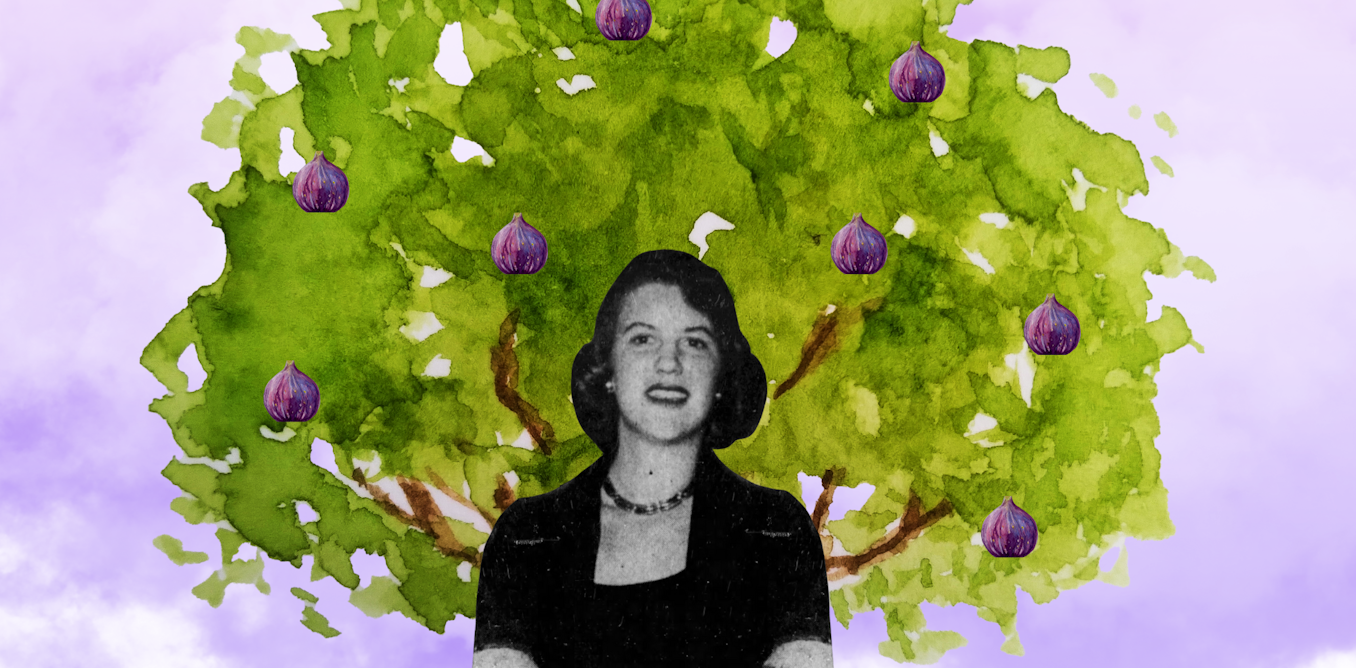In chapter seven of Sylvia Plath’s The Bell Jar (1963), protagonist Esther Greenwood imagines her life branching out before her like a green fig-tree. Each individual fig on the branches represents a different “wonderful future” – a family, a successful career, romance, travel, fame, etc.
High-achieving Esther has innumerable figs she can choose from, yet she envisages herself “starving to death” in the crook of the tree because she can’t make up her mind on which of the figs she should choose.
Her indecision stems from the knowledge that choosing one wonderful future means losing out on the other, equally appealing opportunities. She wants to experience all of them, but knows she cannot, and, in the end, spends so long deciding that every single fig rots and falls to the ground, dead.
By wanting to do everything, Esther misses her chance to do anything at all. This is a metaphor about wasted potential, fears of choosing the wrong pathway, and feeling rushed into making decisions before you truly know what you want. There is little wonder that it appeals to teenagers.
The “fig tree analogy”, as it is known online, is beloved by gen Z and has become a TikTok staple over the last three years. It was first discussed on the platform as part of the 2023 “Roman Empire” meme, with female users citing it as an example of something they constantly think about.
It then reached a new peak in early 2024 thanks to the “my fig tree” trend, in which users (again, predominantly young women) wrote future hopes and dreams onto a stock image of a fig branch in videos featuring accompanying audio of the passage being read aloud.
Looking for something good? Cut through the noise with a carefully curated selection of the latest releases, live events and exhibitions, straight to your inbox every fortnight, on Fridays. Sign up here.
This trend was, in essence, a way for people to share their dream jobs – with career pathways as varied as “surgeon” and “influencer” sometimes appearing on a single branch. But it also allowed young users to express their anxieties about planning for the future.
In one video, “I can’t help but wonder if I’m going to be truly happy in [my chosen career] forever” is written beside a beautifully illustrated fig tree. I remember feeling this way myself when I read The Bell Jar for the first time in the middle of university applications and big life choices.
When you are young, it can feel like you have only one choice and can never remake it, which is why Plath’s words spoke to me then and seem to be speaking to hundreds now.
But why exactly is this metaphor resonating so strongly with gen Z?
The girls who are participating in the “my fig tree” trend are not subject to the same binary choice of marriage or career that Esther faced. It is now possible to have loads of lovers and then a husband and family, and neither disqualifies you from also being a “brilliant professor” or “amazing editor” or anything else you wish to be.
In The Bell Jar, Plath treats these things as distinct because they would truly have felt that way in Esther’s time of enforced purity and nuclear families. She was, after all, writing pre-second-wave feminism.
So why, in our fourth-wave feminist world, do women still feel their options are so narrow? It could be because women workers are disproportionately at risk of being displaced by AI, or because other TikTok sensations like the “trad wife” are promoting to young women the very purity culture that Plath rallied against.
Perhaps, for this generation, it really seems urgent to grasp hold of one fig before all are lost.
However, as the “fig tree analogy” goes more and more viral, it is at risk of being removed from its original context. The signs of this are already visible on TikTok, as the passage has in the last month been used to soundtrack #romanticisinglife content and promote fig-themed homeware at a garden centre.
It was also referenced in a recent episode of reality dating show Love Island, where it was incorrectly named the “fig theory” and not attributed to Plath.
All of this suggests that the passage has now reached an audience of people who have not read The Bell Jar and see the analogy more as some generic life wisdom than a literary device. Indeed, TikTok videos by self-styled philosophers encouraging watchers to pick any or every fig off the tree instead of being paralysed by indecision like Esther are gaining traction.
While these may prove helpful to Zoomers unsure about their future pathway, I feel that the conversation around this metaphor is increasingly overlooking the fact that Esther is unable to choose a fig because she is depressed.
The real meaning of the fig tree analogy
The Bell Jar may be a novel about coming of age as a woman, but it’s also, at its core, the story of a woman having a breakdown. In the pages preceding the “fig tree analogy”, Esther calls herself “dreadfully inadequate” and claims that “I was only purely happy until I was nine years old”.
So, in the context of the novel, the metaphor can be read as a product of depressive thinking. It is not meant to be a universal truth.
Instead, it represents the subjective thoughts of a narrator who feels herself a failure, despite her plentiful opportunities, because she is mentally ill. Turning Plath’s prose into a theory or philosophy or meme minimises its darker aspects, particularly as the popular TikTok audio that accompanies “fig tree analogy” videos often cuts off before the figs fall, due to the app’s preference for short content.
Some users may well have participated in the “my fig tree” trend without even realising that the quotation ends with Esther losing everything.
Perhaps it should be concerning so many young people relate to a narrator who becomes so overwhelmed by her conflicting ambitions that she attempts to kill herself. I certainly wonder how Plath would feel about her words now being treated as emblematic of a collective female experience. If nothing else, I am sure she would be disappointed at how little has changed in 60 years.
This article features references to books that have been included for editorial reasons, and may contain links to bookshop.org. If you click on one of the links and go on to buy something from bookshop.org The Conversation UK may earn a commission.

The post “Sylvia Plath’s ‘fig tree analogy’ from The Bell Jar is being misappropriated” by Elisha Wise, English, University of Sheffield was published on 07/22/2025 by theconversation.com


































Leave a Reply